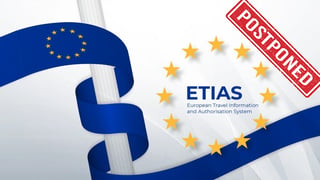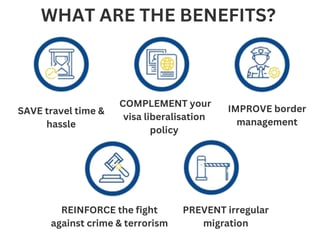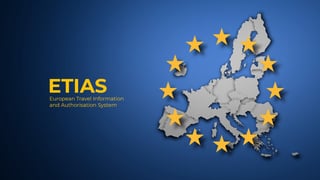- News >
- ETIAS Rollout Delayed to 2025
ETIAS Rollout Delayed to 2025
The new visa waiver program for Europe’s Schengen Area will be arriving later than expected. The latest announcement from the European Union (EU) has stated that the ETIAS system will now be launched in 2025 instead of 2024.
The European Travel Information and Authorisation System (ETIAS) has been in the works for several years.
It is planned to be essential for visitors to Schengen countries, including most of the EU, as well as Switzerland, Norway, Iceland, and Liechtenstein.
The latest delay to ETIAS comes as a result of a delay in the Entry/Exit System — the central database that ETIAS will rely on.

Who is Impacted?
The new regulations will apply to all individuals who previously enjoyed visa-free travel privileges to Europe. This includes travellers from countries like the United States, Canada, Australia, New Zealand, and various other nations. An approved ETIAS will be mandatory for entry into any of the ETIAS member states, which encompass popular destinations such as France, Germany, Italy, Spain, and others.
Irrespective of age, every traveller will be obligated to procure an ETIAS. The granted authorization will remain valid for a span of 3 years or until the expiry date of the passport.
Main objective of the ETIAS

The introduction of the European electronic travel authorization, ETIAS, stems from the heightened terrorist threat faced by Europe. This initiative aims to enhance border controls and pre-arrival screenings for all incoming visitors as a proactive response. Under this measure, travellers will be subjected to inquiries about their intended journeys within Europe.
It's important to note that individuals who do not secure an ETIAS will be unable to embark on flights or cruise ships destined for ETIAS member countries.
Application procedure of the ETIAS
Travellers will need to complete an online application form encompassing a range of inquiries related to biometrics, travel history, and security. Following the submission of the ETIAS application, it will undergo electronic processing within a span of 96 hours, with the resulting authorization being sent via email.
During the evaluation process, passenger data will be cross-referenced against various European and global databases, including no-fly lists, in order to detect potential threats of terrorism and criminal activity. Individuals identified through these checks will be denied entry under the ETIAS program. For cases where no additional verifications are necessary, the majority of applications are anticipated to be processed within 1 hour.
Holders of a valid ETIAS will gain the privilege to travel to countries within the ETIAS member category. This encompasses a significant portion of sought-after European destinations for both tourism and business, such as France, Germany, Spain, Italy, and 18 other nations.

Rules for Completing the Online ETIAS Application
Although seemingly minor, errors can creep into various stages of the ETIAS application process, from filling out and reviewing the form to submitting and making payments. Here are several application guidelines to assist applicants in ensuring a smooth process, reducing the likelihood of mistakes that could potentially impact the application outcome adversely.
- Filling out the ETIAS Application Form
Thoroughly read and comprehend each question or statement on the ETIAS form before furnishing your response.
Provide honest answers for every query on the ETIAS application form. Avoid altering your responses based on assumptions about approval chances.Automated systems that process electronic visa and visa waiver applications cross-reference applicant data across multiple databases to verify information consistency. Providing false information may lead to both application denial and entry refusal at the EU border.
Given that many online visa and visa waiver applications come with a time limit, approximately 20 minutes, work through your application within this time frame to prevent loss of data.
- Reviewing and Submitting the Application
Accurate biometric data input is crucial. During your review, double-check biometric details like name, date of birth, gender, citizenship country, and passport information. Overlooking this step could render your application void before your EU journey and even result in entry denial to Europe.
Upon confirming the accuracy of your provided information, proceed to submit your application.
- Payment for Your ETIAS Application
During payment, make sure to utilise a payment card accepted by ETIAS, ensuring no holds, blocks, or insufficient funds in your account. A declined payment or payment error might lead to non-processing and disapproval of your ETIAS application.
Regardless of your application's outcome, refrain from initiating a charge reversal (chargeback) as this action might prompt ETIAS to withdraw your application due to non-payment.
- Additional Considerations for Your ETIAS
Lastly, endeavour to steer clear of any legal issues before your travel, as this could influence your ETIAS authorization even if you received approval prior to any arrest or conviction. New information coming to light could lead EU authorities to flag and potentially revoke or annul your ETIAS authorization.
The Schengen Visa: Differences, Applications, and Confusion Clarified
Distinguishing the Schengen Area from the European Union is crucial, with 26 nations in the Schengen area, most of which are also EU members. However, exceptions exist:
- Republic of Ireland
- Cyprus
- Croatia
- Bulgaria
- Romania
Of these, Bulgaria and Romania are in the process of joining the Schengen area.
Conversely, non-EU countries like Iceland, Norway, Switzerland, and Liechtenstein are part of the Schengen area, enabling freedom of movement without ETIAS or Schengen Visas.
ETIAS vs. Schengen Visa
Non-visa travellers to Europe, totaling 60 countries, will need authorization when ETIAS launches in2025. This authorization can be ETIAS or a Schengen Visa—a choice between the two.
ETIAS is an electronic system linked to the passport, granting entry to the EU, but not necessarily the Schengen area for non-EU citizens. On the other hand, a Schengen Visa is manually entered into the passport, allowing travel within the 26 member states. However, it is specific to the applied country, not valid for all Schengen countries. A Schengen Visa permits a maximum stay of 90 days within a six-month period after entry.
Application Process
ETIAS application takes about 20 minutes online. It requires personal information, travel history (conflict zones visited), and criminal record details. After database checks, acceptance or rejection is often prompt, but manual checks might take longer. Payment, currently seven euros, is required.
Applying for a Schengen Visa is an in-person process at the embassy or consulate of the destination. This non-automated process can take six weeks or more.
Additional requirements include:
- A passport with two blank pages for entry/exit stamps
- Validity extending three months past visa expiry
ETIAS vs. Schengen Visa Variations
ETIAS has one electronic format, whereas Schengen Visas have different variations with diverse conditions:
- Category A: Transit
- Category C: Short-term stay
- Single Entry Visa
- Double Entry Visa
- Multiple Entry Visa
ETIAS or Schengen Visa for UK Citizens?
Non-EU citizens needing no visa for European travel must acquire proper documentation post ETIAS. UK citizens will require approved ETIAS authorization for European travel.
FAQS
Why has the launch of ETIAS been delayed to 2025?
The launch of ETIAS has been postponed to 2025 due to various factors that have necessitated additional preparations and adjustments, ensuring a smooth and effective implementation.
Who will be affected by the delay in ETIAS launch?
The delay impacts all travellers who were expecting the implementation of ETIAS in previous years, such as 2020, 2022, and 2023. Visitors from countries with visa-free access, like the United States, Canada, Australia, New Zealand, among others, will need an approved ETIAS when travelling to participating member countries in Europe.
What is the purpose of ETIAS?
ETIAS is introduced as a response to the growing threat of terrorism in Europe. Its primary goal is to bolster border controls and enhance security checks for all incoming travellers, contributing to a safer and more secure travel environment.
How do I apply for an ETIAS?
The application process involves completing an online form with various biometric, travel, and security-related questions. After submission, your application will be processed electronically within 96 hours, and the authorization will be sent via email.
What happens if I do not obtain an ETIAS?
Travellers who fail to secure an approved ETIAS will be unable to board planes or cruise ships destined for ETIAS member countries. Airlines and cruise operators will verify ETIAS validity during check-in, and without a valid ETIAS, boarding will be denied.
What is the validity of the ETIAS authorization?
The ETIAS authorization remains valid for a period of 3 years or until the expiration date of your passport, whichever comes first.
Can I still travel to EU member countries if I have a Schengen visa?
Yes, if you currently require a Schengen visa for travel to EU member states, this requirement remains unchanged despite the introduction of ETIAS.
What mistakes should I avoid when applying for ETIAS?
To ensure a successful application, carefully read and comprehend each question on the form before responding. Provide accurate and honest information, as falsifying details can result in denial of entry. Double-check biometric data, review your application thoroughly, and use a payment card accepted by ETIAS when paying for the application.
How can legal issues impact my ETIAS authorization?
Any legal troubles before your travel could affect your ETIAS authorization, even if it was granted prior to the legal issues. EU authorities have the authority to flag and potentially revoke or annul your ETIAS authorization based on new information.
